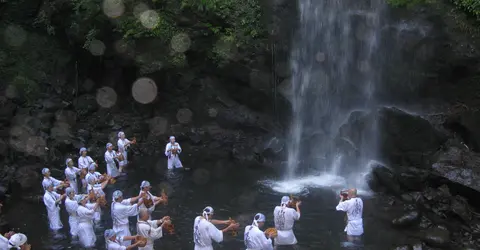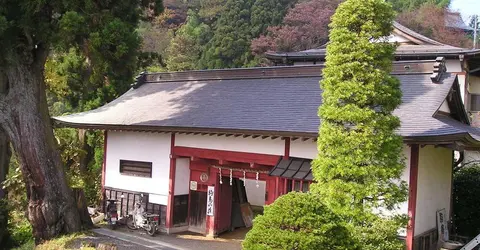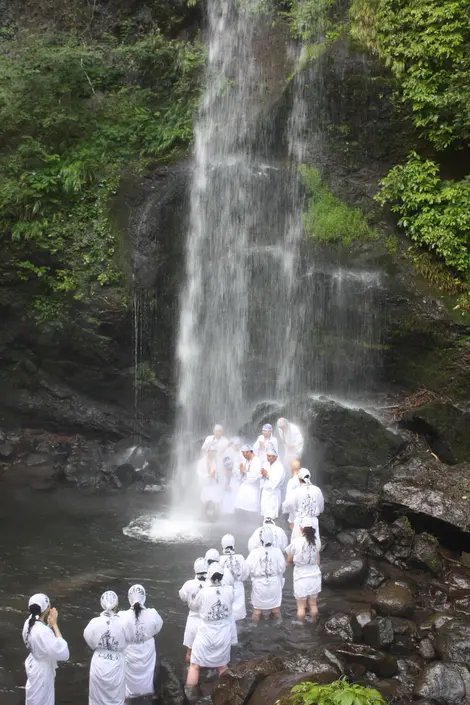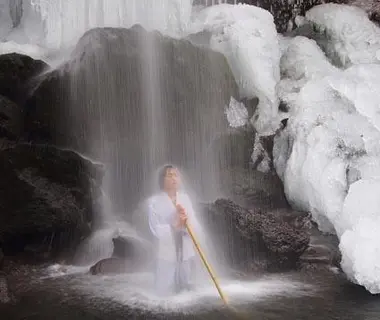Takigyô: "the asceticism of the waterfall" 滝行
- Published on : 01/07/2020
- by : I.D.O./Ph.L
- Youtube
A millennial Japanese ritual accessible to all
Spiritual research, challenge or simple curiosity, takigyô or "asceticism under the waterfall", a practice of religious origin which consists of remaining for a few minutes under the jets of a waterfall, has become popular with the uninitiated. It is practiced under the supervision of a Buddhist monk, a Shinto priest, or simply a guide.
A millennial Japanese practice
The various Japanese Buddhist sects have always had ascetic practices, ranging from misogi - a purifying ritual that consists of sprinkling oneself with cold water or even entering lakes or rivers in the middle of winter - to fasting for several days, passing through walking on fire... Takigyo, " the asceticism of the waterfall ", is one of these practices. Like all other forms of asceticism, it is meant to purify the heart and wash away negative feelings and/or bad destiny. As close as possible to nature, we also get closer to the gods whose blessing we obtain.
- Read also: Hiwatari, the firewalking festival
For purists, it is considered a kind of rebirth. Water from the waterfall is compared to the amniotic fluid in which the fetus moves. Under this divine water, the believer finds the innocence and purity of an unborn child. He can therefore start another life, cleansed of everything.
For centuries, this asceticism, which requires great concentration and regular training, was reserved for initiates: Buddhist monks but also Shinto priests, shamans, and above all the yamabushi, these monks recluse in the mountains practicing shugendo, a set of esoteric rites and various asceticisms.
An ancestral tradition accessible to all
However, for ten years, this form of asceticism seems to have become "fashionable" and is accessible to everyone. She is very popular with (young) women who, traditionally, are often excluded from these religious rites. Many foreign tourists also want to experience this unique experience during a stay in Japan.
For some, this religious practice is rather synonymous with entertainment. Some wellness clubs offering this experience even call it a "detox day"! Thirst for experience, desire for communion with nature, desire to excel or simply to change their minds, the reasons were given by these budding ascetics are numerous... Closer to religion, some participants also mention the need to purify oneself, to ward off bad luck by "this gift of oneself" to nature.
The demand is there, various organizations of a non-religious nature (sports clubs, tourist agencies, etc.) have been organizing days to experience takigyo for several years. with the assistance of a guide. Some even offer to film the feat and sell the DVD.
Some temples or shrines also offer this activity to members.

Takigyo, the asceticism of the waterfall
IoT
In practice, what is Takigyo?
Despite the real dangers of immersion in cold, sometimes icy water, some tours claim to be open to everyone, from children to the elderly. Their conditions are minimal, it is enough to declare themselves in good health. They nevertheless follow religious rituals. After a prayer to the god of the waterfall, participants don karate attire (underneath which bathing suits are sometimes recommended). This is followed by warm-up exercises and, after a greeting or a prayer to the waterfall, the protagonists first spray themselves with water from the pool of the waterfall. Then comes the purifying act of bravery: you put yourself under flowing water, sometimes with the help of a stick to keep yourself upright. No more than a minute and a half for novices, more for regulars who want it.
Buddhist monks and Shinto priests who accept the participation of lay people in their takigyô sessions are more demanding. Participants must observe strict rules: mourners (who have lost a family member during the year), women having their period that day, or those in poor physical condition must abstain. As for those who participate, they must not have drunk alcohol the day before the asceticism, nor have had sexual intercourse. Women should not wear makeup, or even wear nail polish or jewelry. The dress consists of a simple white tunic – similar to that which the deceased is dressed for their funerals. These "ascetics" are expected to be filled with humility, repentance, and gratitude.
The practice of asceticism is much more ritualized, with the monk or priest reciting prayers, invoking the gods, and performing various magical gestures. The "ascetics" will then follow the monk under the waves of the waterfall in a mystical atmosphere.
- Read also: Spiritual immersion
Where to Experience Takigyo in Japan
Want to try Takigyo? Note that there are several places in Japan where it is possible to enjoy the waterfalls in a supervised way. The water can sometimes be capricious, it is strictly not recommended to try it alone. Participants must be in good physical condition, and a waiver will usually need to be signed before starting the activity.
1. Benefits of Yuhi no Taki Waterfall (Kanagawa)
Close to Tokyo, the organization Shugennokai regularly organizes exercises under Yuhi no Taki, a miraculous waterfall renowned for its healing properties. Indeed, the waterfall would be a high place of asceticism! And the region's religious have been coming here for more than 1,000 years to enjoy its benefits.
The activity here lasts one hour and includes the climb to the bathing place, costume, cane, sake, and a commemorative DVD of the experience. Shoes, towels, and bathing suits are to be brought.
FURTHER INFORMATION
Address : Yuhinotaki, 2335 yakurazawa Mimamiashigara-city, Kanagawa, Japan
Price: 9,000 yen per person ($79/72€), the possibility of reduction if the activity is done by more than 5 people.
Reservation: by e-mail via the Shugnenokai website
Directions: The organization welcomes participants at the south exit of Shimmatsuda station at 9 am (Odakyu line)
2. Asceticism in the mountains at Bentendre Taki (Yamanashi)
Prized for its mountains and hot springs, the Yamanashi region is also very popular with Takigyo enthusiasts for its waterfalls. At the Bentendre temple, the Bentendre Taki waterfall is a perfect example. Lost in the middle of the surrounding relief, it regularly welcomes several groups of pilgrims for asceticism supervised by local monks. A prayer is said before beginning the session, and clothing is provided by the establishment.
FURTHER INFORMATION
Address : 1245 Akazawa, Hayakawa-cho, Minamikoma-gun, Yamanashi, 409-2733 Japan
Price: to be requested when booking
Reservation: by phone at 0556-45-2122
Directions: 30 min by car from Hadakajima station (Minobu line)
- Read also: Yamanashi and 10 things to do in Mount Fuji
3. Stay in a shukubo at Komadori Sanso (Chichibu)
At Mount Mitake, Mr. Baba and his wife welcome visitors to their shukubo for an exceptional stay. A Shinto priest at Musashi Mitake Shrine, the owner has been guiding pilgrims through the forest and teaching them the basics of Zen for nearly 20 years. After a hearty homemade breakfast, he also teaches them the way of Takigyô, which he has been practicing since he was 17 years old.
FURTHER INFORMATION
Address: 155 Mitakesan, Ome, Tokyo 198-0175
Price: from 8,800 yen per night breakfast included ($77/71€)
Reservation: request for information on the official Shukubo website
Route: 6 min by cable car from Takimoto station (8 min by bus from Mitake station)

At Mount Mitake, Mr. Baba welcomes visitors to his shukubo
booking.com















